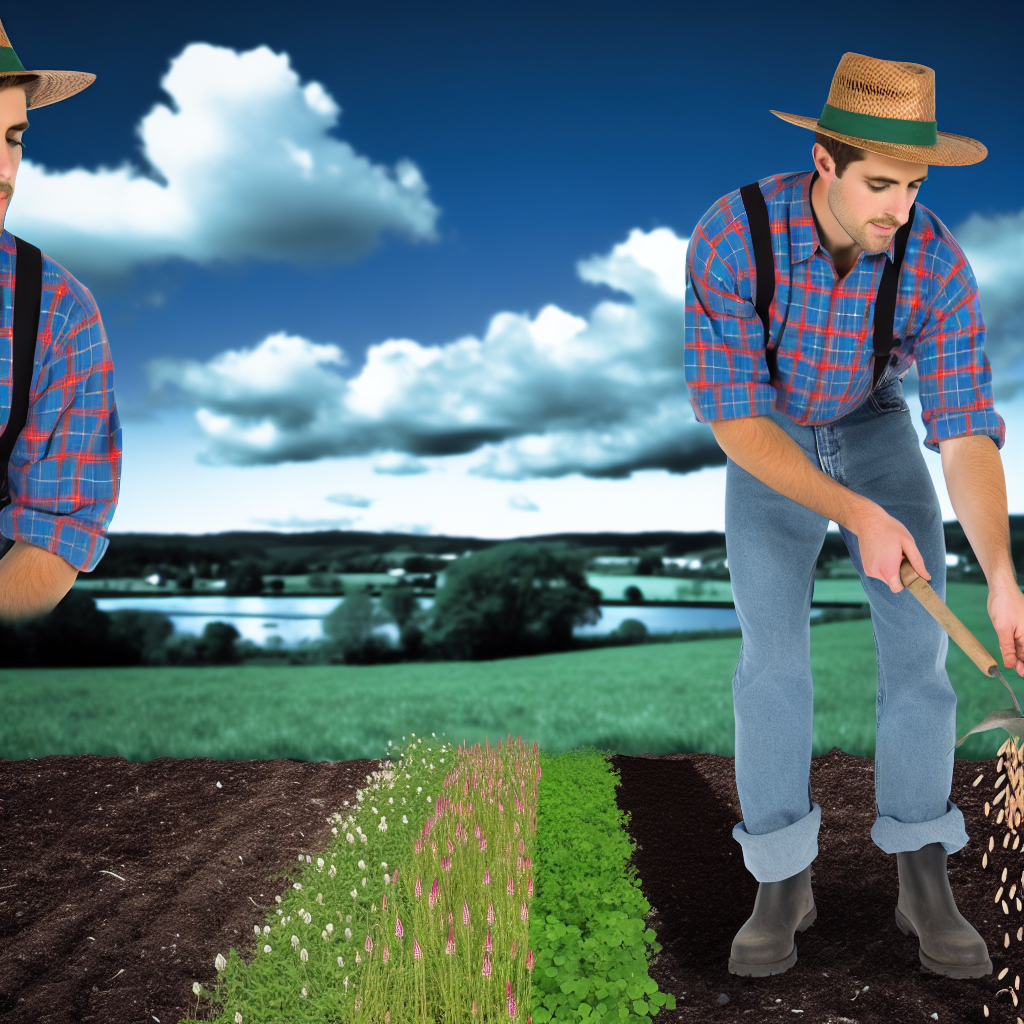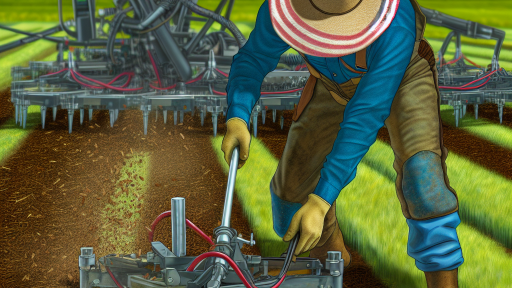Introduction to Cover Crops and Their Purpose
Cover crops play a vital role in sustainable agriculture.
They enhance soil health while preventing erosion.
Farmers plant these crops during off-seasons or between main crops.
This practice promotes soil cover and improves nutrient cycling.
What Are Cover Crops?
Cover crops are typically grasses, legumes, or other plants.
They grow quickly and cover the soil effectively.
Farmers use them to restore soil health and fertility.
Benefits of Cover Crops
Cover crops provide numerous benefits to the environment.
First, they increase organic matter in the soil.
Additionally, they reduce soil compaction over time.
Moreover, they help to suppress weeds and pests.
Enhancing Soil Health
These crops contribute to the build-up of beneficial soil organisms.
Microbial activity thrives in healthy soils with cover crops.
Ultimately, this leads to improved nutrient availability for crops.
Preventing Erosion
Cover crops play a crucial role in preventing soil erosion.
Transform Your Agribusiness
Unlock your farm's potential with expert advice tailored to your needs. Get actionable steps that drive real results.
Get StartedTheir roots help to bind the soil together effectively.
This protection is especially important during heavy rain events.
Supporting Biodiversity
Planting cover crops fosters greater biodiversity in fields.
This diversity supports various ecosystems and wildlife.
Farmers benefit from more resilient agricultural environments.
Carbon Sequestration Benefits
Cover crops also play a significant role in carbon sequestration.
They capture carbon dioxide from the atmosphere during photosynthesis.
Consequently, this process reduces greenhouse gas emissions.
How Cover Crops Sequester Carbon
As cover crops grow, they store carbon in their biomass.
This carbon eventually returns to the soil when plants decompose.
Over time, this practice can significantly improve soil carbon levels.
Long-Term Implications
Incorporating cover crops promotes sustainable carbon management.
This strategy is essential for combating climate change.
Additionally, it enhances overall farm productivity and resilience.
Understanding Carbon Sequestration
Definition of Carbon Sequestration
Carbon sequestration refers to the process of capturing and storing atmospheric carbon dioxide.
This process can occur naturally or through human intervention.
It plays a crucial role in managing greenhouse gas emissions.
Importance of Carbon Sequestration
Carbon sequestration helps combat climate change by reducing CO2 levels in the atmosphere.
This reduction is vital for stabilizing global temperatures.
Moreover, it enhances soil health, leading to improved agricultural productivity.
It also promotes biodiversity within ecosystems.
Methods of Carbon Sequestration
Carbon sequestration can be achieved through various methods.
Natural processes include forest growth and soil development.
On the other hand, technological solutions involve capturing CO2 from industrial processes.
Showcase Your Farming Business
Publish your professional farming services profile on our blog for a one-time fee of $200 and reach a dedicated audience of farmers and agribusiness owners.
Publish Your ProfileBoth approaches contribute to climate change mitigation.
Potential Benefits for Agriculture
Farmers can benefit significantly from carbon sequestration practices.
Cover crops, for example, improve soil organic matter and enhance carbon storage.
This practice can also boost overall crop yields.
In addition, it helps maintain soil structure and reduces erosion.
Challenges and Considerations
While carbon sequestration offers many advantages, challenges exist.
The costs associated with implementation can be high for farmers.
Moreover, not all agricultural practices are equally effective in sequestering carbon.
Therefore, careful planning and research are essential for success.
Types of Cover Crops and Their Specific Benefits for Soil Health
Leguminous Cover Crops
Leguminous cover crops, such as clover and vetch, enrich the soil with nitrogen.
They fix atmospheric nitrogen, improving soil fertility naturally.
Additionally, these crops enhance microbial activity in the soil.
More microbes lead to better nutrient cycling and organic matter decomposition.
Furthermore, they help suppress weeds, minimizing the need for herbicides.
Grassy Cover Crops
Grassy cover crops, like rye and barley, offer excellent soil protection during winter months.
They reduce soil erosion by stabilizing the soil structure.
These crops also improve moisture retention in the soil.
Moreover, they add organic matter when they decompose.
This process enhances the soil’s overall health and fertility.
Brassica Cover Crops
Brassica cover crops, such as radishes and mustards, can break compacted soil layers.
Their deep roots create channels for water infiltration and root growth.
Additionally, these crops can help suppress diseases and pests.
Their biofumigant properties promote soil health and balance.
They also contribute to increased biodiversity in agricultural ecosystems.
Multi-Species Cover Crop Mixes
Using multi-species cover crop mixes combines the benefits of various crops.
This diversity can improve soil structure and nutrient availability.
It enhances ecosystem resilience against pests and diseases.
Furthermore, mixed cover crops foster a diverse microbial community.
This contributes to stable and healthy soil over time.
Discover More: Water Conservation Practices in Organic Crop Farming
Mechanisms of Carbon Sequestration in Agricultural Practices
Understanding Carbon Sequestration
Carbon sequestration refers to the process of capturing and storing atmospheric carbon dioxide.
This process occurs naturally and can be enhanced through specific agricultural practices.
In essence, it reduces the amount of carbon dioxide in the atmosphere.
The Role of Cover Crops
Cover crops significantly contribute to carbon sequestration in agricultural systems.
They capture carbon through photosynthesis and store it in plant biomass.
This biomass eventually adds organic matter to the soil upon decomposition.
Consequently, this increases soil carbon content.
Soil Health and Carbon Storage
Soil health plays a crucial role in carbon storage capabilities.
Healthy soils can sequester carbon more effectively than degraded soils.
Organic matter from cover crops improves soil structure and microbial activity.
Showcase Your Farming Business
Publish your professional farming services profile on our blog for a one-time fee of $200 and reach a dedicated audience of farmers and agribusiness owners.
Publish Your ProfileAdditionally, it enhances nutrient cycling and water retention.
Practices That Enhance Sequestration
Several agricultural practices promote effective carbon sequestration.
- No-till farming minimizes soil disturbance and maintains carbon stores.
- Crop rotation helps diversify plant roots and improves soil health.
- Manure application adds organic matter and nutrients, boosting carbon content.
The Impact of Agroforestry
Agroforestry systems integrate trees with crops and livestock.
This combination captures additional carbon through tree biomass.
It also protects soil and reduces erosion.
Moreover, agroforestry enhances biodiversity and ecosystem resilience.
Measuring Carbon Sequestration
Measuring carbon sequestration in agriculture involves various techniques.
Soil sampling provides data on carbon content changes over time.
Remote sensing technology offers insights into land-use changes.
Additionally, modeling frameworks can predict potential sequestration outcomes.
Find Out More: Economic Advantages of Using Cover Crops on Farms
Economic Advantages of Implementing Cover Crops for Carbon Farming
Cost-Reduction Benefits
Implementing cover crops significantly reduces input costs.
Farmers can lower expenditures on fertilizers and pesticides.
These crops naturally enhance soil fertility and health.
Consequently, farm operations become more sustainable.
Increased Soil Productivity
Cover crops improve soil structure and moisture retention.
Healthy soils lead to better yields over time.
Farmers witness higher production levels across various crops.
This boost in output directly impacts profitability.
Enhanced Resilience to Climate Variability
Cover crops provide protection against soil erosion.
They also mitigate the impacts of droughts and floods.
Farmers benefit from more stable crop production schedules.
This stability effectively minimizes financial risks.
Access to Incentives and Grants
Many government programs support sustainable farming practices.
Farmers can access grants for implementing cover crops.
These financial incentives help offset initial costs.
Additionally, sustainability efforts potentially boost marketability.
Market Demand for Sustainable Products
Consumers increasingly prefer products from sustainable sources.
Cover crops enhance the environmental credibility of farm operations.
This improvement can lead to premium pricing opportunities.
Profits can increase as market demand grows for eco-friendly products.
Find Out More: Seasonal Trends In Pest And Disease Forecasting

Case Studies: Successful Implementation of Cover Crops and Carbon Sequestration
Overview of Case Studies
Implementing cover crops has proven successful worldwide.
These case studies highlight diverse farming environments.
Additionally, they demonstrate significant carbon sequestration benefits.
Case Study: Green Valley Farm
Green Valley Farm adopted cover crops in 2020.
Farmers planted clover and rye during winter months.
This decision improved soil health drastically.
Moreover, it increased organic matter levels in the soil.
As a result, the farm enhanced its carbon sequestration rate.
Showcase Your Farming Business
Publish your professional farming services profile on our blog for a one-time fee of $200 and reach a dedicated audience of farmers and agribusiness owners.
Publish Your ProfileResults Achieved
Green Valley Farm reported a 30% increase in soil organic carbon.
Additionally, crop yields improved by 15% the following season.
Farmers observed healthier crops and reduced erosion.
Case Study: Sunny Acres Agronomy
Sunny Acres Agronomy implemented a diverse cover cropping system.
The system included peas, radishes, and barley in rotation.
This approach increased soil biodiversity significantly.
Furthermore, it captured more carbon dioxide from the atmosphere.
Impacts on the Environment
Sunny Acres reported a noticeable reduction in fertilizer use.
This change led to decreased runoff into nearby waterways.
Farmers achieved a more sustainable farming operation overall.
Case Study: Oak Ridge Cooperative
Oak Ridge Cooperative utilized cover crops on a large scale.
The cooperative focused on enhancing carbon storage practices.
Cover crops played a central role in their sustainability strategy.
They partnered with local universities for research and development.
Long-Term Benefits
The cooperative experienced enhanced soil structure over time.
As a result, water retention improved during droughts.
This adaptation led to reduced irrigation costs for members.
The cooperative has shown promising results.
Implications for Sustainable Agriculture
These case studies illustrate the effectiveness of cover crops.
They offer tangible benefits for carbon sequestration efforts.
Farms of all sizes can adopt these practices successfully.
The environmental advantages are clear and significant.
Gain More Insights: Integrating Nutrient Management on Your Farm
Challenges and Considerations in the Use of Cover Crops for Carbon Sequestration
Understanding the Complexities
Cover crops play a crucial role in enhancing soil health.
However, there are several challenges associated with their implementation.
Farmers often face issues with timing and crop selection.
Furthermore, the benefits may vary depending on the local climate.
It is essential to tailor cover crop selections to specific environmental conditions.
Economic Factors
The initial costs of planting cover crops can deter farmers.
Many producers worry about the economic return on investment.
Additionally, organic farmers may have limited resources for cover crop establishment.
Therefore, evaluating the potential long-term benefits is necessary.
Management Practices
Effective management of cover crops requires knowledge and skill.
Farmers must adjust their practices around planting and terminating cover crops.
Furthermore, they need to monitor the crops to maximize their benefits.
Inadequate management can lead to poor performance and failure to sequester carbon.
Technical and Training Resources
Access to adequate technical resources is essential for successful implementation.
Farmers may require training on specific crop varieties and their benefits.
Extension services can provide vital support and guidance to producers.
Therefore, collaboration between farmers and agricultural experts is crucial.
Showcase Your Farming Business
Publish your professional farming services profile on our blog for a one-time fee of $200 and reach a dedicated audience of farmers and agribusiness owners.
Publish Your ProfileBalancing Cover Crops and Main Crops
Cover crops must not compete with main crops for nutrients and water.
Proper planning is necessary to avoid growing conflicts during the growing season.
Farmers need to consider crop rotation and market demands when establishing cover crops.
Maintaining this balance is critical for overall farm productivity.
Potential Pest Issues
Cover crops can inadvertently attract pests and diseases.
Therefore, farmers need to be vigilant in monitoring these risks.
Proper pest management strategies must be integrated into the farming system.
In this way, farmers can mitigate potential negative impacts on yield.
Future Trends in Agricultural Practices
Cover Crops and Climate Change Mitigation
Cover crops play a vital role in modern agriculture.
They mitigate climate change effects and enhance soil health.
Farmers are increasingly adopting these practices to improve sustainability.
Additionally, cover crops sequester carbon, reducing greenhouse gases.
The Role of Cover Crops in Soil Health
Cover crops improve soil structure and fertility.
They promote microbial activity, which is crucial for nutrient cycling.
Moreover, they help regulate soil temperature and moisture content.
This natural process enhances crop productivity over time.
Economic Benefits of Cover Cropping
Adopting cover crops can lead to significant cost savings.
They reduce the need for chemical fertilizers and pesticides.
This approach lowers input costs and increases profit margins.
Moreover, healthier soils yield better crops, promoting long-term viability.
Future Trends in Cover Crop Adoption
The use of cover crops is expected to rise in the coming years.
Farmers will likely use innovative techniques for enhanced effectiveness.
Specifically, they may integrate advanced technology, such as sensors.
This will allow for better monitoring of soil health and moisture levels.
Policy Implications and Support
Government policies are starting to favor sustainable practices.
Incentives and subsidies can encourage cover crop adoption.
Furthermore, educational programs raise awareness about benefits.
This support will be essential for widespread implementation.
Additional Resources
Cover Cropping to Improve Climate Resilience | USDA Climate Hubs
Cover crops and carbon sequestration: Lessons from U.S. studies …




